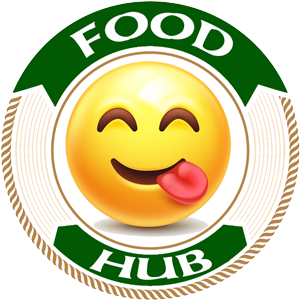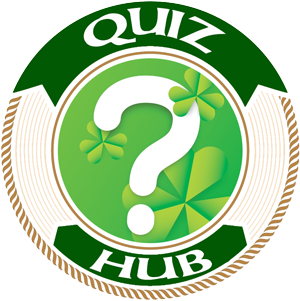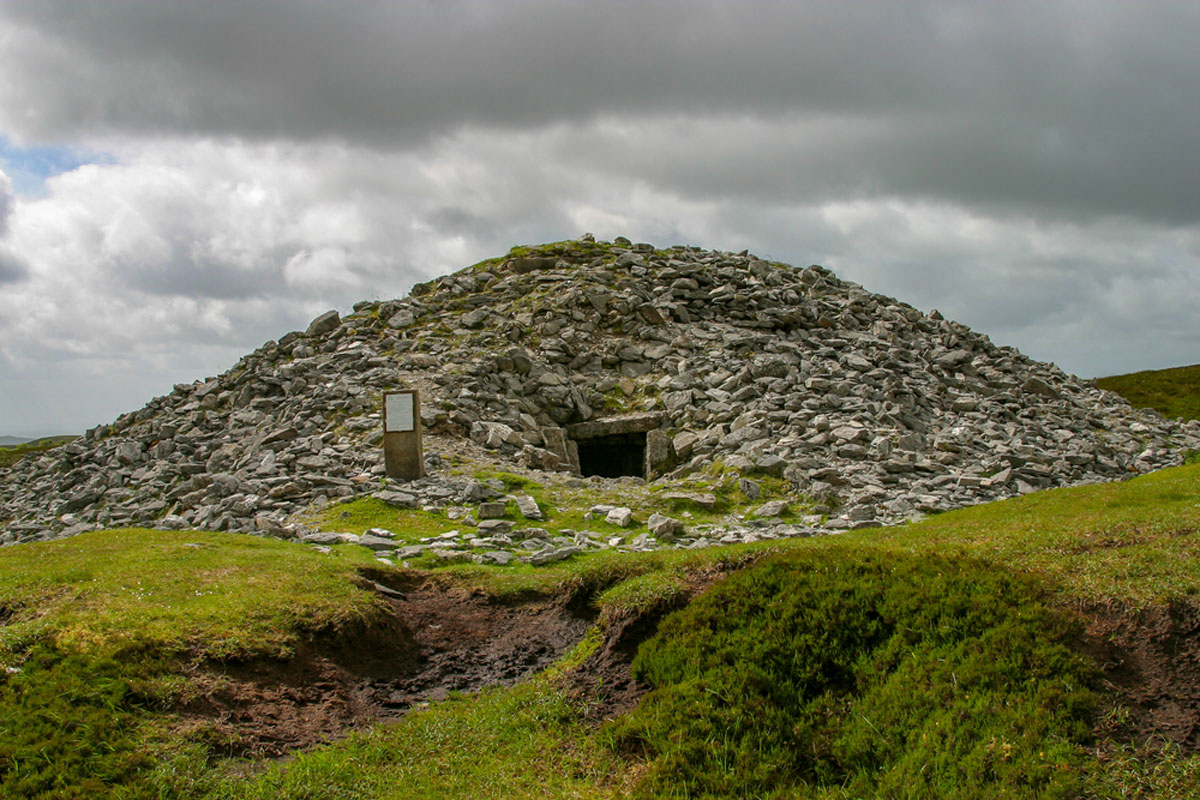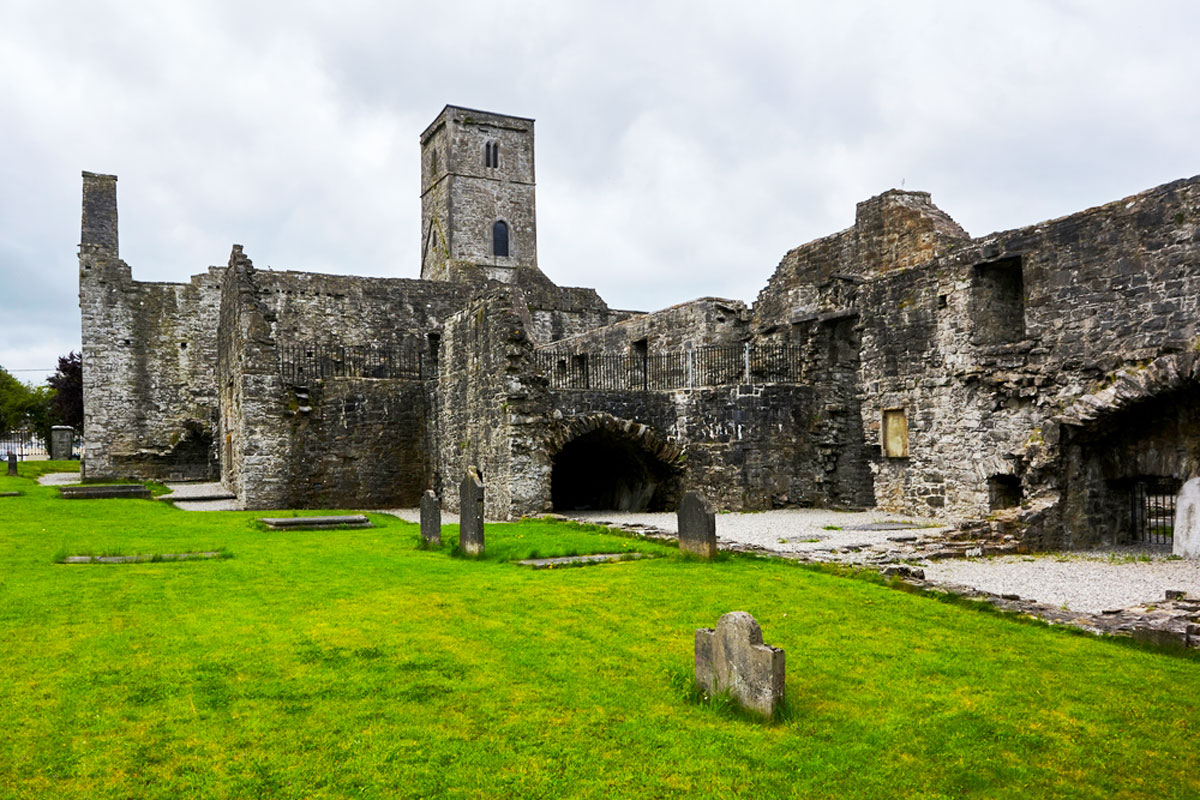The Enigmatic Landscape of Carrowkeel
Carrowkeel, nestled in the rolling hills of County Sligo, Ireland, is a place shrouded in mystery and wonder. This ancient landscape, dotted with megalithic tombs dating back over 5,000 years, holds the key to unlocking secrets of Ireland’s prehistoric past.
Ancient Origins
The megalithic tombs of Carrowkeel are among the oldest and most significant archaeological sites in Ireland. Built by early Neolithic communities between 3700 and 3200 BCE, these impressive structures stand as testament to the ingenuity and craftsmanship of our ancient ancestors. Carrowkeel’s tombs, known as passage tombs or cairns, were constructed using massive stone slabs and earth, carefully arranged to create burial chambers and passageways.
Sacred Landscape
The landscape surrounding Carrowkeel is imbued with a sense of sacredness and spirituality. Situated on a plateau overlooking the stunning Bricklieve Mountains, the tombs are strategically positioned to align with the movements of the sun and stars, suggesting a deep understanding of celestial phenomena by the builders. This alignment reflects the importance of astronomy and cosmology in the religious beliefs and rituals of Neolithic societies.
Archaeological Discoveries
Excavations at Carrowkeel have revealed a wealth of archaeological treasures, including human remains, pottery, and ceremonial objects. These finds provide valuable insights into the daily lives, social structures, and belief systems of the people who inhabited this region thousands of years ago. The tombs themselves are marvels of engineering, with some featuring intricate carvings and engravings that offer clues to their significance in Neolithic society.
Cultural Heritage
Carrowkeel is not only a site of archaeological significance but also a place of cultural heritage and national pride. It represents a connection to Ireland’s ancient past and serves as a reminder of the enduring legacy of our ancestors. As such, it has been designated as a National Monument, protected by law to ensure its preservation for future generations.
Visitor Experience
Today, visitors to Carrowkeel have the opportunity to step back in time and explore this fascinating archaeological landscape. Guided tours offer insights into the history and significance of the tombs, while the surrounding natural beauty provides a serene backdrop for reflection and contemplation. For those with a sense of adventure, hiking trails lead to panoramic viewpoints where the majesty of Carrowkeel’s ancient monuments can be fully appreciated.
The Construction of Megalithic Tombs
The construction of the megalithic tombs at Carrowkeel is a testament to the skill and ingenuity of the Neolithic people who built them. These ancient structures, dating back over 5,000 years, were carefully designed and meticulously constructed using locally sourced materials and simple tools.
Building Materials
The primary building materials used in the construction of Carrowkeel’s megalithic tombs were stone and earth. Large slabs of limestone, quarried from nearby outcrops, were used to create the chambers and passageways of the tombs. These massive stones, some weighing several tons, were carefully transported to the site and arranged to form the structural framework of the tombs.
Construction Techniques
The construction process of megalithic tombs was labor-intensive and required careful planning and coordination. The stones were shaped and dressed using rudimentary tools, such as antler picks and stone axes, before being positioned in place. The earth was then used to fill the gaps between the stones, creating solid walls and roofs.
Architectural Features
Carrowkeel’s megalithic tombs exhibit a variety of architectural features, reflecting the diversity of Neolithic burial practices and beliefs. Many of the tombs are characterized by long, narrow passageways leading to central chambers, where the remains of the deceased were laid to rest. Some tombs feature intricate carvings and engravings on the stone slabs, possibly depicting religious symbols or ancestral figures.
Alignment and Orientation
One of the most remarkable aspects of Carrowkeel’s megalithic tombs is their precise alignment with celestial phenomena. Many of the tombs are oriented towards significant solar and lunar events, such as the winter solstice or the phases of the moon. This suggests that the builders had a sophisticated understanding of astronomy and may have used the tombs for observing and marking important astronomical events.
Symbolism and Significance
The construction of megalithic tombs like those at Carrowkeel was not just a practical undertaking but also a deeply symbolic and meaningful act. These monuments served as sacred spaces for ritual and ceremony, where the living could commune with the spirits of the deceased and honor their ancestors. The careful alignment of the tombs with the movements of the heavens reflects a belief in the interconnectedness of the physical and spiritual worlds.
Cultural and Religious Significance
Carrowkeel’s megalithic tombs hold immense cultural and religious significance, offering a glimpse into the spiritual beliefs and practices of Ireland’s ancient inhabitants. These sacred sites were more than just burial chambers; they were places of ritual, ceremony, and reverence for the ancestors.
Ancestral Worship
Central to the cultural and religious beliefs of the Neolithic people who built Carrowkeel’s megalithic tombs was the concept of ancestral worship. The tombs served as repositories for the remains of the deceased, who were venerated and honored by their descendants. Rituals and offerings were made to appease and honor the spirits of the ancestors, ensuring their continued protection and guidance.
Life and Death
The construction of megalithic tombs like those at Carrowkeel was closely tied to beliefs about the cycle of life and death. These ancient monuments served as portals between the world of the living and the realm of the dead, allowing for communication and interaction with ancestral spirits. The careful alignment of the tombs with celestial events reflected a belief in the continuity of life beyond death and the eternal journey of the soul.
Cosmic Connections
The alignment of Carrowkeel’s megalithic tombs with celestial phenomena, such as the winter solstice or the phases of the moon, suggests a deep connection to the cosmos. For the Neolithic people who built these monuments, the movements of the stars and planets held profound symbolic and spiritual significance. The tombs may have been used as astronomical observatories, allowing for the tracking of celestial events and the marking of important calendar dates.
Ritual Practices
Carrowkeel’s megalithic tombs were the setting for a variety of ritual practices and ceremonies, conducted by priests or shamans who held spiritual authority within the community. These rituals may have included offerings of food, drink, or precious objects, as well as prayers, chants, and incantations to invoke the blessings of the ancestors. The tombs were also used for communal gatherings and feasts, where the living would come together to celebrate important milestones and events.
Legacy and Continuity
The cultural and religious significance of Carrowkeel’s megalithic tombs extends far beyond the Neolithic period, leaving a lasting legacy that continues to resonate with people today. These ancient monuments are a tangible link to Ireland’s prehistoric past, reminding us of the enduring power of ritual, belief, and connection to the land.
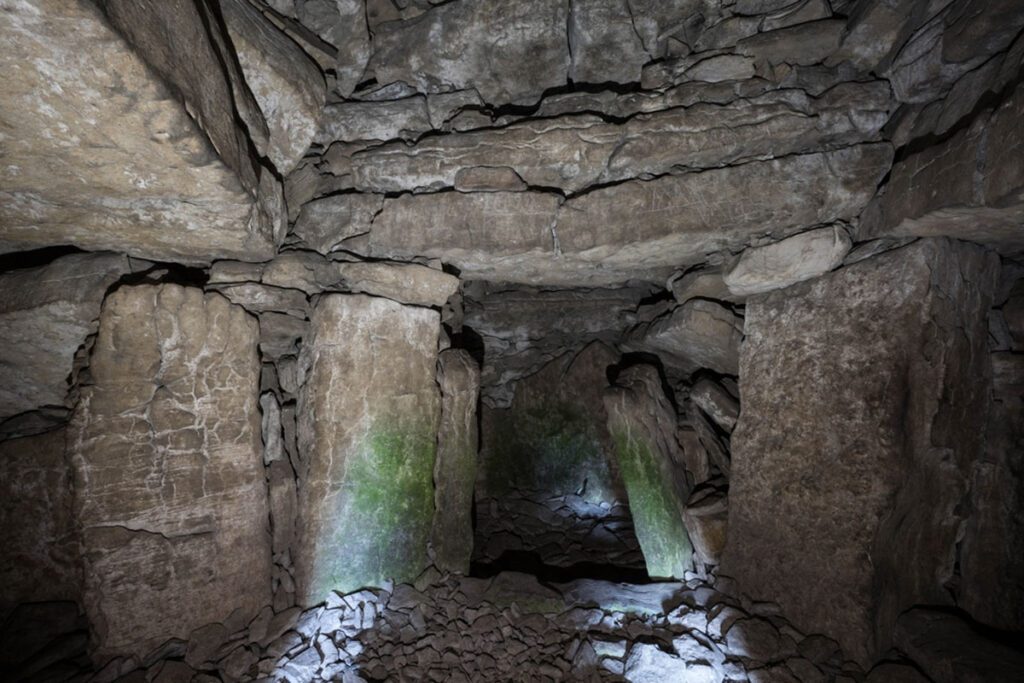
Archaeological Discoveries
Excavations at Carrowkeel have yielded a wealth of archaeological discoveries, shedding light on the lives and beliefs of the people who inhabited this ancient landscape. These finds offer valuable insights into Neolithic society and the cultural practices associated with megalithic tomb construction and use.
Human Remains
One of the most significant discoveries at Carrowkeel is the presence of human remains within the megalithic tombs. Excavations have revealed skeletal remains, often accompanied by grave goods such as pottery, jewelry, and tools. Analysis of these remains provides clues about the diet, health, and lifestyle of the individuals buried at Carrowkeel, as well as their social status and kinship relationships.
Ceremonial Objects
In addition to human remains, archaeologists have uncovered a variety of ceremonial objects and artifacts at Carrowkeel. These include pottery vessels, often decorated with intricate designs or motifs, as well as stone tools and implements. These objects were likely used in ritual activities and ceremonies conducted within the tombs, offering glimpses into the spiritual beliefs and practices of Neolithic society.
Artistic Representations
Some of the megalithic tombs at Carrowkeel feature artistic representations in the form of carvings and engravings on the stone slabs. These intricate designs may depict abstract symbols, geometric patterns, or stylized representations of animals and humans. The meaning of these carvings is not fully understood, but they likely held symbolic significance in the religious and cultural context of Neolithic society.
Structural Features
The architectural layout and construction techniques of the megalithic tombs themselves provide valuable insights into the technological capabilities of the Neolithic people who built them. The precise alignment of the tombs with celestial events suggests a sophisticated understanding of astronomy and mathematics, while the use of massive stone slabs demonstrates advanced engineering skills.
Environmental Evidence
Archaeological investigations at Carrowkeel have also uncovered environmental evidence, including pollen samples, plant remains, and animal bones. Analysis of these materials provides valuable information about the natural environment surrounding Carrowkeel during the Neolithic period, as well as the diet and subsistence strategies of the people who lived there.
These archaeological discoveries paint a vivid picture of life at Carrowkeel thousands of years ago, offering tantalizing glimpses into the beliefs, rituals, and daily activities of Ireland’s ancient inhabitants.
Legacy and Preservation
Carrowkeel’s megalithic tombs stand as enduring monuments to Ireland’s ancient past, preserving the memories and traditions of Neolithic society for future generations. As we reflect on the significance of these remarkable structures, it is essential to consider their legacy and the importance of their preservation for both cultural and scientific purposes.
Cultural Legacy
Carrowkeel’s megalithic tombs are integral to Ireland’s cultural heritage, representing a tangible link to the country’s prehistoric past. They serve as powerful symbols of continuity and resilience, connecting us to the beliefs, rituals, and traditions of our ancestors. Through their preservation and interpretation, we can gain a deeper understanding of Ireland’s rich cultural tapestry and the diverse communities that have inhabited this land for thousands of years.
Scientific Value
From a scientific perspective, Carrowkeel’s megalithic tombs are invaluable sources of information about Neolithic society and the development of human civilization in Ireland. Archaeological excavations have provided valuable insights into the lives and behaviors of the people who built and used these structures, shedding light on topics such as social organization, technological innovation, and cultural exchange. Continued research at Carrowkeel has the potential to yield further discoveries and expand our knowledge of Ireland’s ancient past.
Preservation Efforts
Preserving Carrowkeel’s megalithic tombs is essential for safeguarding their cultural and scientific value for future generations. Efforts to protect and conserve these ancient monuments include measures such as stabilizing the structures, monitoring environmental conditions, and implementing visitor management strategies to minimize impact. Collaboration between archaeologists, heritage organizations, and local communities is key to ensuring the long-term preservation of Carrowkeel and other archaeological sites across Ireland.
Public Engagement
Engaging the public in the exploration and interpretation of Carrowkeel’s megalithic tombs is crucial for fostering appreciation and understanding of Ireland’s ancient heritage. Educational initiatives, guided tours, and outreach programs can help raise awareness about the significance of these monuments and inspire interest in archaeology and history among people of all ages. By encouraging active participation and dialogue, we can ensure that Carrowkeel remains a living testament to Ireland’s past for generations to come.
In conclusion, Carrowkeel’s megalithic tombs are more than just ancient structures; they are windows into Ireland’s distant past and symbols of our shared human experience. By preserving and interpreting these remarkable monuments, we honor the legacy of the past and pave the way for a brighter future rooted in understanding, respect, and appreciation for Ireland’s rich cultural heritage.
Historical and Cultural Sites
- Carrowmore Megalithic Cemetery: One of the largest and oldest collections of ancient stone tombs in Europe.
- Lissadell House and Gardens: A historic estate linked to the Yeats family, featuring beautiful gardens and exhibitions.
- Sligo Abbey: A well-preserved Dominican friary dating back to the 13th century.
- Drumcliffe Church and Graveyard: The final resting place of the poet W.B. Yeats, located beneath the majestic Benbulben.
Natural Attractions
- Benbulben Mountain: A striking table mountain and one of Ireland’s most iconic landmarks.
- Knocknarea Mountain: Home to Queen Maeve’s Cairn, an ancient stone tomb with panoramic views of Sligo Bay.
- Lough Gill: A serene lake surrounded by lush forests, celebrated in W.B. Yeats’ poetry.
- Strandhill Beach: A popular spot for surfing, beach walks, and stunning sunsets.
Scenic Drives and Villages
- Rosses Point: A charming seaside village with sandy beaches and coastal walks.
- Enniscrone: Known for its long sandy beach and seaweed baths.
- Tubbercurry: A vibrant town that hosts the annual South Sligo Summer Festival.
- Ballymote: A historic town featuring Ballymote Castle and the nearby Eagles Flying sanctuary.
- Easkey: A quaint village famous for its surfing and rugged coastline.
Lakes and Water Activities
- Lough Gill: Perfect for boat tours, kayaking, and exploring the Isle of Innisfree.
- Ballisodare Bay: A peaceful spot for birdwatching and coastal activities.
- Lough Talt: A tranquil lake nestled in the Ox Mountains, ideal for fishing and walking.
- Mullaghmore: Known for its sandy beaches, fishing, and big-wave surfing.
- Sligo Bay: Offers kayaking, paddleboarding, and opportunities to explore the Wild Atlantic Way.
Unique Experiences
- Yeats Trail: Explore sites associated with the life and works of W.B. Yeats, including his grave and Lough Gill.
- Voya Seaweed Baths, Strandhill: Indulge in a traditional Irish spa experience using natural seaweed.
- Eagles Flying, Ballymote: A sanctuary showcasing birds of prey with interactive flying displays.
- Surfing in Strandhill and Easkey: Renowned surf destinations for beginners and professionals alike.
County Sligo offers a unique blend of natural splendor, historical intrigue, and cultural richness. From the dramatic peaks of Benbulben to the tranquil shores of Lough Gill, Sligo is an inspiring and unforgettable destination for all travelers.
Helpful Resources

